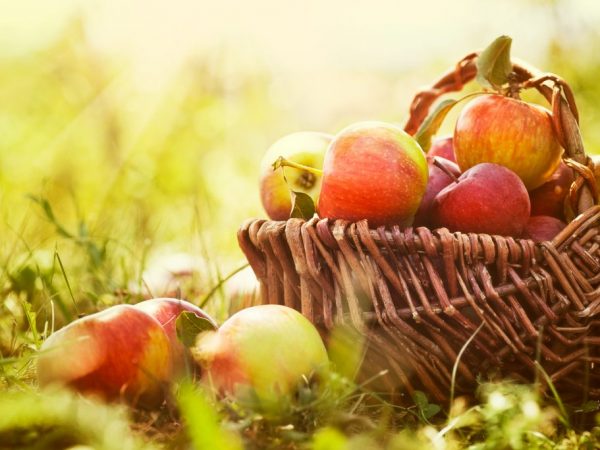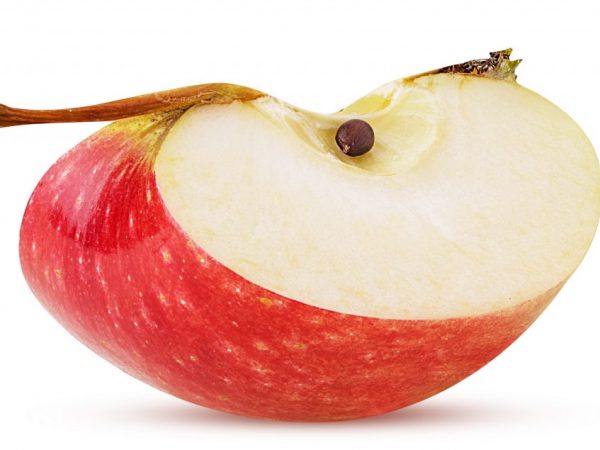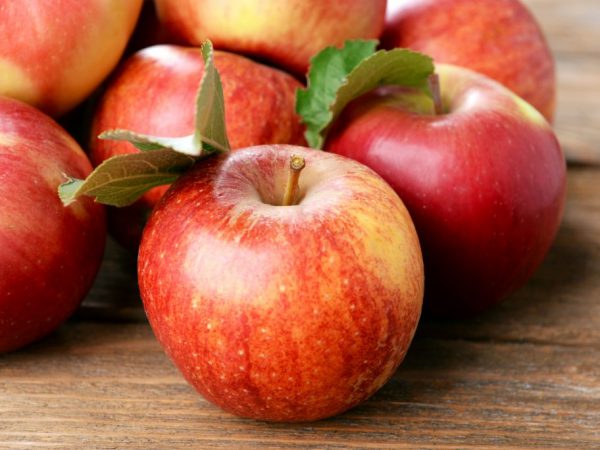Features of cultivation of the bugle apple tree
The Apple-tree Hornist is a vivid example of the symbiosis of fruit crops. Academician Kotov from the Sverdlovsk region received it in several stages. Brown was crossed with Ural apples, and the resulting variety, having passed free pollination, turned out to be very tasty.
- Characteristics of the variety
- Description of the tree and fruit
- Advantages and disadvantages
- Taste characteristic
- Yield
- Pollinator varieties
- Winter hardiness
- Disease and pest resistance
- Landing
- Timing
- Landing technology
- Care
- Watering
- Top dressing
- Pruning and shaping the crown
- Harvesting and storage
- Features of cultivation in different regions
- Gardeners' reviews about this variety

Features of cultivation of the bugle apple tree
Characteristics of the variety
The summer apple variety "Hornist" has a high resistance to frost, and also endures the bad weather of Siberia.
Trees hardened in such conditions grow powerful and strong, with a dense crown, although in its youth the crown has the shape of a pyramid.
Despite the average size of the fruit, the harvest is rich, and the apples are juicy, soft, with characteristic stripes on the red peel. It is good to make drying, compotes, jam from them.
Description of the tree and fruit
Trees grown in the Urals are tall, powerful with a boom in the shape of a pyramid.
Over time, the branches of the tree grow on the sides, and their overall appearance changes to a more graceful one.
The best yields come from trees grown on ringlets.
The foliage is dense, but the leaf itself is small, and its edges are finely serrated.
The apples are smaller than medium, but catchy, the waxy coating adds shine and appeal. The fruits can be either light or red, with splashes or scarlet stripes.
Advantages and disadvantages
This variety has a number of positive aspects.
- early harvests;
- frost resistance;
- regular fruiting;
- resistance to scab and other fungi.
A number of disadvantages can also be identified.
- self-infertility;
- short shelf life of fruits (up to 1 month);
- low vitamin C content
Taste characteristic

Sweet and sour apples
Gornist apples have a light yellow pulp, they are dense, and have a high juice content. The taste is sour, with bright sweet notes.
Studying the chemical composition, they note a low content of vitamin C and ascorbic acid, sucrose - 9.3%, acids - 0.7%.
The fruits are ready for consumption immediately after harvest and do not need to ripen. They need to be consumed or sold quickly (within 20 days), otherwise they will soon lose their quality. Delicious juices are made from this species.
Yield
The bugler begins to produce crops by the age of 6, one apple tree brings up to 100 kg of fruit.
Regular bud formation yields a crop without interruption. This means that after the very first harvest, the tree will bear fruit every year.
Pollinator varieties
Self-fertile, the cultivar needs pollinator trees nearby.
For the garden, any other pollinating tree is suitable, in which the flowering time will coincide with the Hornist.
It does not matter the varietal neighborhood - it all depends on the taste preferences of the gardener.
Winter hardiness
The Hornist proudly wins the winter hardiness championship.
The filling is able to withstand temperatures up to - 50 ºС.The tree patiently survives all the weather conditions of its habitat.
It does not freeze and gives excellent yields after icing, after frost and even after heavy rains.
Disease and pest resistance
The variety is distinguished by a particularly high immunity to scab. It is rare to find leaves or fruits affected by this ailment, as well as by other fungi.
Immunity to spores does not rid the tree of parasites: aphids, weevils, flower beetles, this is not a complete list of pests.
Better to fight them with sticky trapping belts. You can also treat trees with insecticides.
Landing
This variety does not differ in planting features. He, like everyone else, requires proper care, fertile soil and access to light.
Timing
It is better if the planting is in the fall, a month before the onset of frost. Until the harsh Ural winter comes, the roots will have time to take root, and in the spring they will begin to actively develop.
Landing technology
When determining the planting site, the gardener must take into account the fact that the tree will grow to a large size, so the site must match.
The apple tree must be exposed to sunlight. Pick up the soil not sour, the waters should lie low, otherwise they form hills to avoid washing away the roots.
According to the description, a good start before planting would be to put the roots in a solution with phytohormones for a while. When a wide and spacious planting pit is ready, a cushion of fluffed earth is formed at its bottom.
The straightened roots will fit well into it and take root, because after the first watering, the earth subsides and the root collar will go deeper. When the pillow is formed, this will not happen and the neck will remain at the desired level.
Planting should take place carefully, because the slightest injury to the roots or neck will lead to the death of a young tree.
Care

Watering the apple tree is not at all necessary
Key components of care:
- systematic pruning;
- protection against parasites;
- preparation for winter;
- regular fertilization;
- high-quality irrigation.
Watering
Watering is moderate, mostly there is enough seasonal precipitation and melt water after the snow melts. In warm summer, it is recommended to water each tree 3 times a month with a bucket of water.
Top dressing
A good harvest is possible only if the gardener regularly feeds the tree and monitors the composition of the soil and checks it for the presence of minerals and nutrients.
They use organic fertilizers: manure, dung, mullein and humus, as well as mineral fertilizers, which include potassium, nitrogen and phosphorus.
Pruning and shaping the crown
As soon as the tree begins to grow, you need to immediately start pruning it. Particular attention should be paid to trunk branches, as well as those that may suffer from strong winds. Broken off a large branch leaves a large wound, and this is fraught with further infection of the entire tree.
Due to the lack of light, inside the thick branches may die off and not give an ovary, therefore, when pruning, it is extremely important to pay attention to this point.
Apple tree pruning rules:
- the first and second tier should be at a distance of 70 cm. The second and third - 30 cm;
- the angle of indentation between the branch and the conductor should be 45º;
- those branches that are directed to the center must be cut off;
- standing and parallel branches are removed;
- top shoots are cut off;
- leave the central branches at the same distance from each other.
Harvesting and storage
Pouring bears fruit abundantly and for a long time, for 50 years. Harvested by August 20, use can be started immediately.
The shelf life is short - up to a month. Apples are suitable for preparing blanks. The harvest is not subject to special storage.
Despite their appearance and high liquidity, fruits, in most cases, are processed into juices, jam, freezing.
Features of cultivation in different regions
Given that the apple tree has high winter hardiness, it takes root well in the northern regions, in the Urals and Siberia.
Particular attention is paid to the growing soil. The soil in these regions is hard, it needs to be loosened and weeded regularly to ensure sufficient oxygen access to the root system.
Drainage methods or adding mulch to trap moisture and air in the roots may work. These activities will save you from the appearance of weeds.
Gardeners' reviews about this variety
Taking into account all the pros and cons, we can safely say that the Hornist is one of the most unpretentious and easy to grow varieties.
Particular attention should be paid to the habitat and resistance to climatic difficulties. And also the opportunity to give rich harvests not on the most fertile soil.
With proper and regular care, the tree can live up to 50 years.

